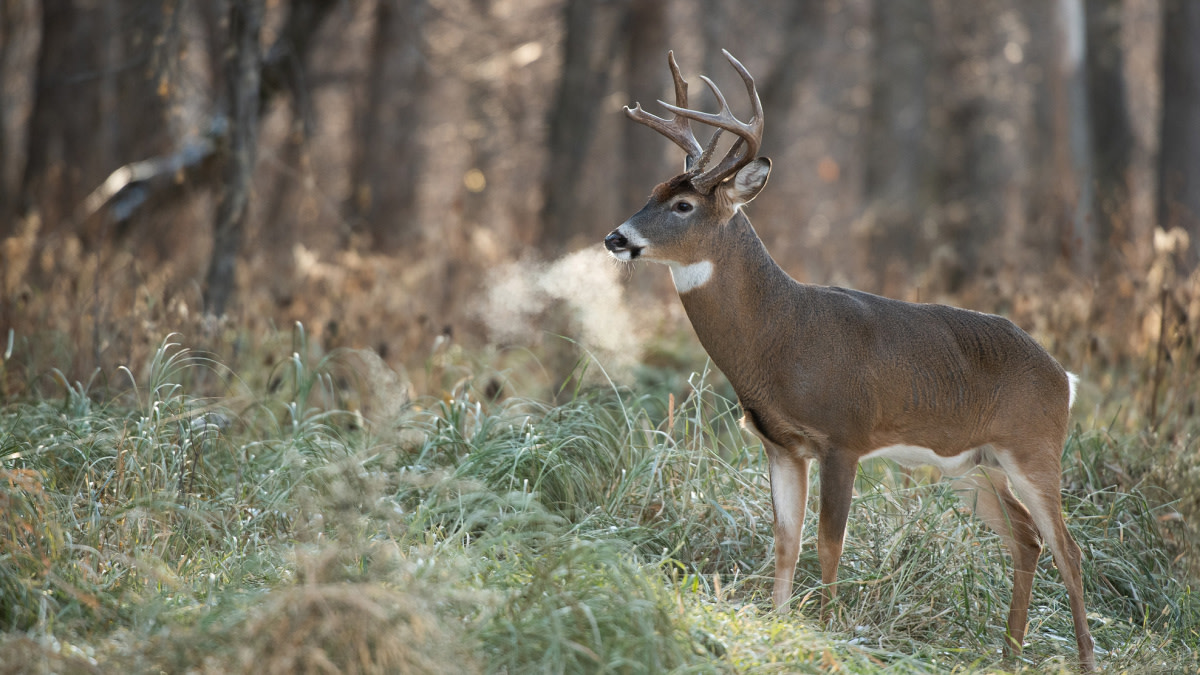
Few things excite deer hunters more than a cold front. The impact of temperature on deer movement (both positive and negative) is almost gospel within the deer hunting community. But, as is the case with barometric pressure, science doesn’t help back up these claims. So, how should a deer hunter make sense of the 10-day forecast in fall?
What Scientists Say
The belief that weather and temperature impact deer movement has inspired a few studies on the topic. In most cases, the results have left weather-focused hunters on shaky ground. Matt Ross of the QDMA simply said, “regardless of weather, bucks move most at dawn and dusk.”
That was the verdict of a Mississippi State University study that hunters prefer to ignore: “In general, we found minimal evidence that weather was having an influence on deer movements. Relationships were weak and parameter estimates were small revealing little biological significance in changes in movement distance with changes in weather.”
As noted in our recent piece examining barometric pressure, another study out of Texas noted that “no correlation was found between hourly means in male activity and temperature.”
The silver lining for believers is that, of all the weather variables considered in such studies, temperature has the closest connection to movement.
“We did see some changes when we had temperature changes,” said Bronson Strickland of Mississippi State University. “When a front was coming through, we might see some changes. But again, it wasn’t that dramatic. It was always subtle.”
Another research project out of North Carolina State University found that “adult male movement, activity, and climatic factors varied by season and period of day, making it difficult to attribute responses solely to climatic factors.” But they also pointed out that air temperature was a consistent predictor of buck movement across all seasons.
What Big Buck Killers Say
If the science is somewhat murky, hunter beliefs are crystal clear. Ask any whitetail hunter and you’ll likely hear that yes, of course, temperature impacts deer movement. To oversimplify it, hot is bad, cold is good, and the change from the former to the latter is best.
“Cool weather changes the psyche of mature bucks. Wrapped in big, thick coats, they don’t move much when it’s 70 degrees,” Mark and Terry Drury wrote in their book, “Giant Whitetails.” “But—BAM!—a cold front hits, and suddenly their internal cooling systems work again. Big deer get up and walk, searching for does and nudging them around. Cool weather makes deer more comfortable, just like it puts a skip in your step.”
Turn just about anywhere else in the whitetail media world and you’ll hear something similar.
“When you see the bottom falling out of a stretch of steady temps, get excited,” Steve Bartylla wrote in “Big Buck Secrets.” “Odds are you are going to have some good hunting.”
I can point to countless similar statements from whitetail experts on the Wired To Hunt Podcast. If I had to summarize the general sentiments on the impact of temperatures on deer movement, it would be this:
A drop of 10 or more degrees in daytime high temperatures tends to elicit a positive increase in deer movement—this seems to be the threshold for a meaningful cold front. Furthermore, cold temperatures in general (compared to the average for that time of year) are almost always a good thing. If you have a cold front hitting your area, it represents one of your best opportunities to catch deer moving a little more than usual. These are the times to call in sick and hunt your best properties or stand locations.
On the flip side, warmer-than-average temperatures decrease daylight activity, or at least push it to only the earliest and latest portions of the day. These are the days to catch up on the honey-do list, hunt low-risk observation stands, or focus on hot weather-specific locations like water holes.
Making Sense of It All
It’s hard to argue with the sheer volume of strong opinions about temperature’s impact on deer movement. While purely anecdotal, my own experiences back this up to a T. While the science is inconclusive, it’s hard to argue with what your own eyes tell you.
Similar to my synthesis of the barometric pressure debate, I question whether scientists and hunters are looking for the same answers.
While I don’t question the validity of the aforementioned studies, I do wonder if we’re measuring for the same end result. Researchers are looking for statistically significant and consistent correlations. But what I and many deer hunters care about is a slight edge that might result in a mature buck moving just a bit further or a few minutes earlier than normal. A difference of five minutes or 50 yards could be the difference between filling a tag and seeing nothing. But would that show up as significant in a study?
When it comes to my own beliefs, and those of the vast majority of the best deer hunters in the country, the answer is as solid as concrete. When temperatures drop, I’ll be in my best stand with the confidence that bucks are going to be moving. I recommend you do the same.
Feature image via Matt Hansen.





